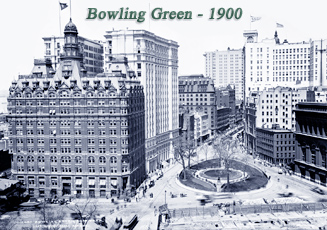
Bowling Green in the 19th Century
In 1733, the piece of land lying at the lower end of the Broadway, fronting to the old Fort, was leased to make a bowling green, with walks therein for the recreation and delight of the people. It continued as so throughout the 19th century.
In 1815, the Custom House at the foot of Broadway, facing the Bowling Green, was demolished. It was erected in 1790, originally for the residence of General Washington (then President of the United States), but the capital was transferred to Philadelphia and it became the Government House. In 1799 it became the Custom House.
Before 1844, the first decorative fountain was installed in the center of the Park, involved with stones (shown in the illustration below). It was commissioned by James Renwick Jr., the architect that later designed the Grace Church and St. Patrick's Cathedral. Around the 1850s, a new fountain was installed. Another fountain was installed between 1860s–1885.
The Great Fire on July 19, 1845 destroyed many buildings in the area. The Adelphi Hotel, one of the tallest commercial buildings in the City, with six floors, was consumed by fire.
In 1896, the monument to Abraham de Peyster, New York’s mayor (1691 to 1694) was installed in the Park. It was removed in 1972.
The 16-story Bowling Green Offices Building, 11 Broadway, was erected between 1895 and 1898. Five additional stories were built in 1920–1921.
The Great Fire in New York City on July 19, 1845, seen from the Bowling Green fountain. Hand-colored illustration lithographed and published by N. Currier in the same year. Nearly 300 buildings destroyed according to this illustration. Source: Library of Congress.
Bowling Green in the 19th Century

|
Copyright © Geographic Guide - Old NYC. 19th Century. |